
Otterton Priory was a priory in Otterton, Devon founded before 1087 and suppressed in 1414. The tower of the parish church is the major remaining structure of the monastery. The manor house probably reuses parts of the monastery's fabric.

Otterton Priory was a priory in Otterton, Devon founded before 1087 and suppressed in 1414. The tower of the parish church is the major remaining structure of the monastery. The manor house probably reuses parts of the monastery's fabric.
It was founded some time before 1087 as an alien priory of Benedictine monks. It was a cell of the monastery of Mont St. Michael in Normandy and in 1332 King John is recorded as creating establishing the priory for four monks. However, it is possible that he simply increased the revenues and improved the buildings of an existing monastery. [1]
In 1332 it was briefly sold off for £120 but later a monk from the parent house probably re-established it. It was finally suppressed in 1414 and the lands associated with it were given to Syon Abbey in Middlesex. [1]
The priory probably stood to the east of the present church on the site, St Michael [1] and the tower would have been between the parochial nave and the east end used by the priory. [2] Other than the tower, no remains of any monastic building are visible. [1] Richard Duke obtained the priory lands at the Dissolution of the Monasteries and some time after 1539 constructed the manor house from part of the monastic buildings by. The manor house is now converted into a number of almshouses. [3]
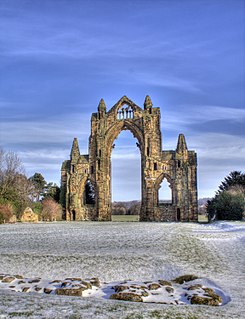
Gisborough Priory is a ruined Augustinian priory in Guisborough in the current borough of Redcar and Cleveland, North Yorkshire, England. It was founded in 1119 as the Priory of St Mary by the Norman feudal magnate Robert de Brus, also an ancestor of the Scottish king, Robert the Bruce. It became one of the richest monastic foundations in England with grants from the crown and bequests from de Brus, other nobles and gentry and local people of more modest means. Much of the Romanesque Norman priory was destroyed in a fire in 1289. It was rebuilt in the Gothic style on a grander scale over the following century. Its remains are regarded as among the finest surviving examples of early Gothic architecture in England.

Alvecote Priory is a ruined Benedictine Priory in Alvecote, Warwickshire, England. The site has been scheduled as an ancient monument. Now very little remains of the priory, most of the walls have been eroded but a fairly high wall remains on one side. The main entrance arch is the most impressive feature, still standing at around 20 feet (6.1 m) high. The attached dovecote also survives, however both the ruined priory and dovecot are on the Heritage at Risk Register due to vandalism and water damage.

Alien priories were religious establishments in England, such as a monastery or convent, which were under the control of another religious house outside England. Usually the mother-house was in France.

Quarr Abbey is a monastery between the villages of Binstead and Fishbourne on the Isle of Wight in southern England. The name is pronounced as "Kwor". It belongs to the Catholic Order of St Benedict.

Edington Priory in Wiltshire, England, was founded by William Edington, the bishop of Winchester, in 1351 in his home village of Edington, about 3+3⁄4 miles (6 km) east of the town of Westbury. The priory church was consecrated in 1361 and continues in use as the parish church of Saint Mary, Saint Katharine and All Saints.

Whalley Abbey is a former Cistercian abbey in Whalley, Lancashire, England. After the dissolution of the monasteries, the abbey was largely demolished and a country house was built on the site. In the 20th century the house was modified and it is now the Retreat and Conference House of the Diocese of Blackburn of the Church of England. The ruins of the abbey are recorded in the National Heritage List for England as a designated Grade I listed building, and are a Scheduled Ancient Monument.
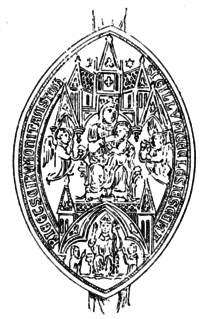
Tavistock Abbey, also known as the Abbey of Saint Mary and Saint Rumon, is a ruined Benedictine abbey in Tavistock, Devon. Nothing remains of the abbey except the refectory, two gateways and a porch. The abbey church, dedicated to Our Lady and St Rumon, was destroyed by Danish raiders in 997 and rebuilt under Lyfing, the second abbot. The church was further rebuilt in 1285 and the greater part of the abbey between 1457 and 1458.
Haltemprice Priory was an Augustinian monastery approximately two miles south of the village of Cottingham in the East Riding of Yorkshire, England. The original monastic buildings have long since gone, although ruins of a farmhouse, built in 1584, remain on site and incorporate some of the Priory stonework.

The Benedictine Priory of St Nicholas or just St Nicholas Priory was a Benedictine monastery founded in Exeter, England, in 1087. At the Dissolution of the Monasteries the church and chapter house range were pulled down but the domestic buildings were left intact. Parts of the north and west ranges of the monastery survive with the west range now being a museum owned by Exeter Historic Buildings Trust.
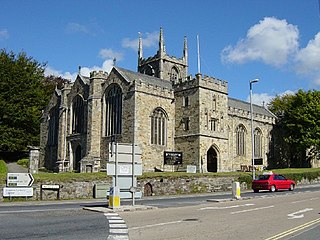
St Petroc's Church, Bodmin, also known as Bodmin Parish Church, is an Anglican parish church in the town of Bodmin, Cornwall, England, United Kingdom.

Forde Abbey is a privately owned former Cistercian monastery in Dorset, England, with a postal address in Chard, Somerset. The house and gardens are run as a tourist attraction while the 1,600-acre (650 ha) estate is farmed to provide additional revenue. Forde Abbey is a Grade I listed building.
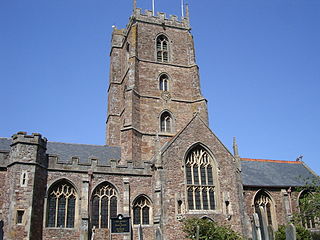
Dunster Priory was established as a Benedictine monastery around 1100 in Dunster, Somerset, England.

Various monasteries and other religious houses have existed at various times during the Middle Ages in the city of Exeter, Devon, England.
Sidmouth Priory was a priory in Devon, England.
Totnes Priory was a priory at Totnes in south Devon, England.

Wilmington Priory was a Benedictine priory in the civil parish of Long Man, East Sussex, England. The surviving building is now owned by the Landmark Trust and let as holiday accommodation. It is both a Grade I listed building and a scheduled monument.
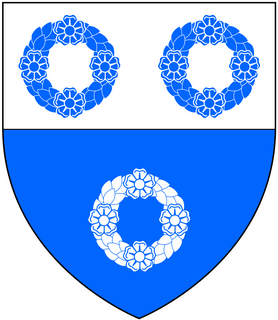
Richard Duke was a lawyer and served as Clerk of the Court of Augmentations which position assisted him in acquiring large grants of former monastic lands in the West Country following the Dissolution of the Monasteries. He served as MP for Weymouth in 1545 and for Dartmouth in 1547 and as Sheriff of Devon in 1563–64.

The Manor of Otterton was a medieval manor in East Devon, England.